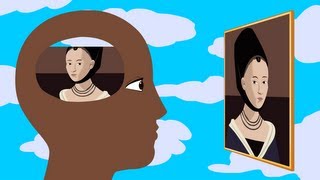(单词翻译:单击)
There's a prevailing attitude that art doesn't matter in the real world.
人们普遍认为艺术在现实世界中并不重要。
But the study of art can enhance our perception and our ability to translate to others what we see.
但事实上,学习艺术会增强我们的洞察力,以及向他人描述我们所看到事物的能力。
Those skills are useful. Those skills can save lives.
这些能力是有用的。这些能力能够拯救生命。
Doctors, nurses, and law enforcement agents can use painting, sculpture, and photography
医生,护士,和执法人员可以使用绘画、雕塑和摄影
as tools to improve their visual acuity and communication skills,
作为工具改善他们的视觉敏锐度以及沟通技巧,
which are critical during investigations and emergencies.
这些技巧在调查和紧急情况下至关重要。
If you're treating an injury, investigating a crime scene,
如果你在治疗伤员,调查犯罪现场,
or trying to describe either of those things to a colleague, art can make you better at it.
或是尝试向你的同事描述这些事情,艺术能使你更擅长这些工作。
Here, imagine you're a seasoned cop or a dedicated doctor, but also imagine you are at a museum and let's look at a painting.
这样吧,想象您是一个经验丰富的警察或是一个尽职尽责的医生,但同时想象你在一个博物馆里让我们看这样一幅画。
Rene Magritte's 'Time Transfixed' of 1938 depicts a mysterious and complex interior
雷内·马格利特1938年创作的《凝聚的时间》描绘了一个神秘而复杂的内部空间,
that invites analysis not unlike that required of a patient's symptoms or the scene of a crime.
对这幅画的分析与对病人症状的分析或对犯罪现场的分析是很相似的。
A miniature train whose origin and destination are unknown is emerging from a fireplace,
一辆起点未知终点也未知的微型火车从一个壁炉中出现,
and the smoke from the locomotive appears to flow up the chimney as if from the fire that is conspicuously absent below.
火车头的烟雾从烟囱中涌出,好像是由火引起的,但在画面下方却全然不见火。
The eeriness of the scene is echoed in the empty living room,
这一场景的怪诞感得到了整个空旷的起居室的呼应,
enhanced by wood-grain floors and decorative wall moldings to the right of the fireplace.
木纹地板,壁炉右边的墙壁装饰更增强了这一荒诞感。
Perched atop the mantelpiece are two candlesticks and a clock.
在壁炉驾上的是两根蜡烛和一个时钟。
Behind these objects is a large mirror that reveals an empty interior and only a partial reflection of the objects before it.
在这些物品后面有一个大镜子,反射出空空如也的房间和在它面前的物品的一部分镜像。
The juxtaposition of the objects surrounding the moving train
这些物品围绕着行驶中的火车摆放,
raises numerous questions for which there seem to be no apparent answers.
让人满肚子的疑问,而且似乎并没有明确的答案。
Did I summarize the painting accurately or leave any details out?
我把这幅画总结得准确吗?还是忽略了什么细节?
It's no big deal if you see something else in a painting, but what if we're both seasoned cops? I call you for back-up.
如果你在画中看到了别的东西,那也没什么大不了的,但如果我们俩都是经验丰富的警察呢?
You show up only to realize the two bank robbing ninjas I'd mentioned were actually six bank robbing ninjas with lasers.
我让你帮我掩护,你来了却发现我所说的两个银行劫匪实际上是六个拿着镭射枪的劫匪。

Close study of art can train viewers to study thoroughly, analyze the elements observed, articulate them succinctly,
对于艺术的仔细研究能够训练观察者全面研究、分析观察到的事物,清晰地描述它们并且整理出问题,
and formulate questions to address the seeming inconsistencies.
解决表现上的不一致。
Scrutinizing the details of an unfamiliar scene, in this case the work of art, and accurately conveying any observable contradictions
对于一个不熟悉的场景详细地调查细节,就这件艺术作品而言,准确地表达能够察觉到的矛盾之处,
is a critically important skill for both people who look at x-rays and those who interrogate suspects.
这无论对那些查看x光片的人还是那些审问嫌犯的人都是至关重要的技能。
Let's interrogate this painting, shall we?
让我们来“审问”一下这幅画的作者,如何?
Okay, Magritte, that's quite a little picture you've painted.
马格利特,这是一幅你画的画。
But why aren't there any train tracks? Why no fire? What happened to the candles?
但你为什么不画火车轨道呢?为什么没有火?那些蜡烛是怎么了?
Why doesn't the fireplace have a little tunnel for the train?
为什么这个壁炉没有火车隧道?
It just comes straight through the wall. And the clock says it's about quarter to one,
火车是直接从墙里开出来的。而且时钟显示时间大约是12点45,
but I'm not sure the light that comes through the window at an angle says it's just past noontime.
但我不确定光线从窗户射进来的角度显示这是刚过中午。
What's this painting all about, anyway?
总之,你这幅画到底想表达什么?
That's when you, my trusty partner, hold me back, then I leave.
就在这时,你作为我可靠的搭档让我停下,然后我离开了。
You give Magritte a cup of coffee and keep grilling him to see if this painting would hold up in court.
你给你马格利特一杯咖啡,继续审问他,看这幅画能否在法庭上站得住脚。
Viewers can provide a more detailed and accurate description of a situation by articulating what is seen and what is not seen.
通过描述看到了什么和没有看到什么,观察者能够提供对一个场景更细节、更准确的描述。
This is particularly important in medicine.
这对于医务工作者尤为重要。
If an illness is evidenced by three symptoms and only two are present in a patient,
如果一种病的确诊要有三种症状,但一位病人只有其中两种症状,
a medical professional must explicitly state the absence of that third symptom,
那么医务工作者必须明确地指出这位病人没有第三种症状。
signifying that the patient may not have the condition suspected.
这意味着这个病人可能并没有患上这种病。
Articulating the absence of a specific detail or behavior known as the pertinent negative
阐明不存在某一特定的细节或行为被称为否定相关。
is as critical as stating the details and behaviors that are present in order to treat the patient.
在治疗病人时,这与阐明存在某种细节和行为是同样关键的。
And conspicuous absences are only conspicuous to eyes trained to look for them.
一些明显不存在的细节只对受过训练的人来说才显而易见。
Art teaches professionals across a wide spectrum of fields
艺术能够指导各行各业的从业人员,
not only how to ask more effective questions about what cannot be readily answered,
不仅能教会他们提出一些无法被轻易回答的有效的问题,
but also, and more importantly, how to analyze complex, real world situations
并且,更重要的是,教会他们分析复杂的现实情况
from a new and different perspective, ultimately solving difficult problems.
通过新的、不同的角度,从而在根本上解决难题。
Intense attention to detail, the ability to take a step back and look differently,
对细节的高度关注、退后一步从不同角度观察的能力,
we want first responders to have the analytical skills of master art historians at least.
我们希望最早的反应者至少具有艺术史大师的分析能力。
Art trains us to investigate, and that's a real world skill if there ever was one.
艺术训练人们的调查能力,这就是一种所谓的现实世界的技能。


